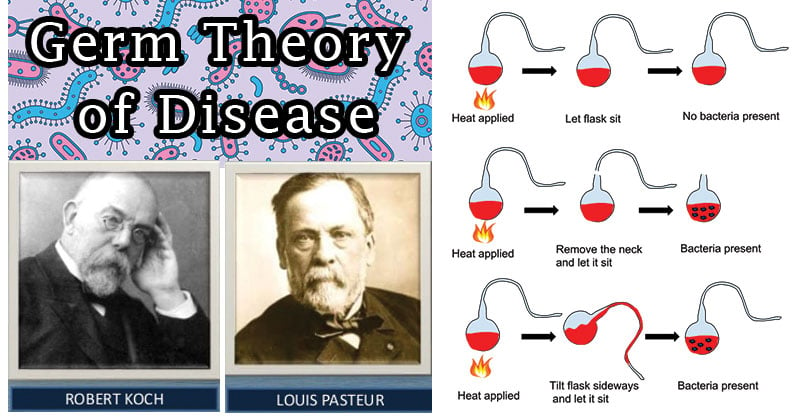- Before the Germ theory of disease, the causes suggested for the occurrence of disease were the effect of supernatural phenomena like planetary alignments, effect of bad bodily humors and the faulty environment.
- For example, in ancient Greece, it was thought that disease was spread not via direct contact with other infected individuals, but rather via infectious “seeds” in the air or food products.
- The predominant theory until germ theory of disease was eventually accepted in the 19th century was termed “miasma theory”, meaning “pollution” or “bad air”.
- Miasma theory stipulated that disease originated from the decomposition of organic matter, causing a noxious vapor harboring disease-causing agents. It was believed that individuals could contract disease by inhaling foul-smelling air associated with contaminated drinking water, unsanitary conditions, and air pollution.
- However, with the subsequent development of new experimental work, research and new theories of different researchers surfacing, the older theories were replaced. Nonetheless, the new theory has withstood scientific scrutiny for centuries.
- The germ theory of disease is the currently accepted scientific theory of disease.
Interesting Science Videos
Germ theory states that certain diseases are caused by the invasion of the body by microorganisms, organisms too small to be seen except through a microscope.

The Establishment of Germ Theory of Disease
- Even before microorganisms were seen, some investigators suspected their existence and responsibility for disease.
- Among others, the Roman philosopher Lucretius (about 98–55 BC) and the physician Girolamo Fracastoro (1478–1553 AD) suggested that disease was caused by invisible living creatures.
- Girolamo Fracastoro proposed the revolutionary theory that infectious diseases are transmitted from person to person by minute invisible particles. He further suggested that infections spread from person to person by minute invisible seeds, or seminaria, that are self-replicating and act on the humors of the body to cause disease.
- His theories were ahead of their time, and it took about 200 years for the microscope to be invented and his theories to be proved.
- In 1840, the German pathologist Friedrich Henle proposed criteria for proving that microorganisms were responsible for causing human disease (the “germ theory” of disease).
- Robert Koch and Louis Pasteur confirmed this theory in the 1870s and 1880s with a series of elegant experiments proving that microorganisms were responsible for causing anthrax, rabies, plague, cholera, and tuberculosis.
- Support for the germ theory of disease began to accumulate in the early nineteenth century.
- Agostino Bassi (1773–1856) first showed that a microorganism could cause disease when he demonstrated in 1835 that the silkworm disease was due to a fungal infection. He also suggested that many diseases were due to microbial infections.
- In 1845, MJ Berkeley proved that the great potato blight of Ireland was caused by a fungus.
- Bassi’s work served to influence Louis Pasteur, who is accredited with the germ theory of disease following his experiments demonstrating the relationship between microorganisms and disease.
- Today, the Germ theory of Disease still remains a guiding theory that underlies contemporary biomedicine.
Besides these, the observations and actions of Ignaz Semmelweis, Joseph Lister and John Snow would retrospectively be acknowledged as contributing to the acceptance of germ theory.
But it was the laboratory researches of Louis Pasteur in the 1860s and then Robert Koch in the following decades that provided the scientific proof for germ theory.
Their work opened the door to research into the identification of disease-causing germs and potential life-saving treatments.
Applications and Importance of the Germ Theory of Disease
- The germ theory is applied to infection control in hospitals, the treatment of food and water, and efforts to control the spread of infection in natural settings. Example: The various vaccination and disease prevention programs.
- Even in the present day, research continues to identify the microbes responsible for diseases, to rapidly and accurately detect their presence, and to devise strategies that will minimize or completely prevent the particular diseases.
- The practices of disinfection, sterilization, personal hygiene, and proper food preparation have their basis in germ theory.
- Knowledge that microorganisms can cause disease spawned efforts to prevent the microbes from coming into contact with people, food, water, and other materials.
- Knowledge that many diseases are caused by microorganisms, and that the microbes can be spread from person-to-person and from an inanimate surface to a person spurred the development of techniques to minimize or prevent microbial spread. One example is asepsis—the treatment of living and non-living surfaces to kill or prevent the growth of associated microorganisms.
- The techniques of modern day molecular biology have an important place in germ theory. Detection and identification of microorganisms based on the presence of target sequences of genetic material is making infection control more rapid and efficient.
- The discipline of epidemiology is rooted in the germ theory. Epidemiology is essentially the germ theory in reverse. Rather than tracing the path from the source of a microbe to the disease, an epidemiologist begins with a disease and then, by various means, determines the source and geographical dissemination of that particular disease.
References
- Murray, P. R., Rosenthal, K. S., & Pfaller, M. A. (2013). Medical microbiology. Philadelphia: Elsevier/Saunders
- Parija S.C. (2012). Textbook of Microbiology & Immunology.(2 ed.). India: Elsevier India.
- Sastry A.S. & Bhat S.K. (2016). Essentials of Medical Microbiology. New Delhi : Jaypee Brothers Medical Publishers.
- http://broughttolife.sciencemuseum.org.uk/broughttolife/techniques/germtheory
- https://www.sciencedirect.com/topics/immunology-and-microbiology/germ-theory-of-disease
- https://biologydictionary.net/germ-theory/
- https://www.britannica.com/science/germ-theory
- https://www.encyclopedia.com/media/educational-magazines/germ-theory-disease
- https://www.ncbi.nlm.nih.gov/books/NBK24649/

More information no comments
Nice compilation. Highly informative and educative and neat.